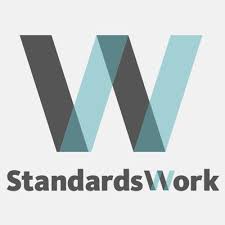Table of Contents
Planning
-
There’s a growing body of research finding that instructional materials can have as large an impact on student outcomes as teacher quality or reduced class size. Developing a process for the selection and implementation of quality instructional materials is more important than ever with the growing number of available resources for both core courses and supplemental materials.
High quality digital instructional materials go beyond the digital textbook to include video, audio, animation, simulations, and interactive applications that are aligned to standards, address educational goals and are accessible for all students.
States with an instructional materials adoption process can be a resource for districts, which can be especially valuable in smaller districts that may lack the human capacity to conduct extensive reviews of materials. Effective planning is essential when selecting quality instructional materials aligned to standards, whether your state adopts resources as a service to districts or your district conducts the adoption process.
-

High-Quality Curricula and Team-Based Professional Learning
With high-quality teaching and high-quality instructional materials students are more likely to learn. Establishing these conditions for all learners will help close achievement gaps. Explore High-Quality Curricula and Team-Based Professional Learning: A Perfect Partnership for Equity for rationale, lessons from practitioners, and action steps.
-
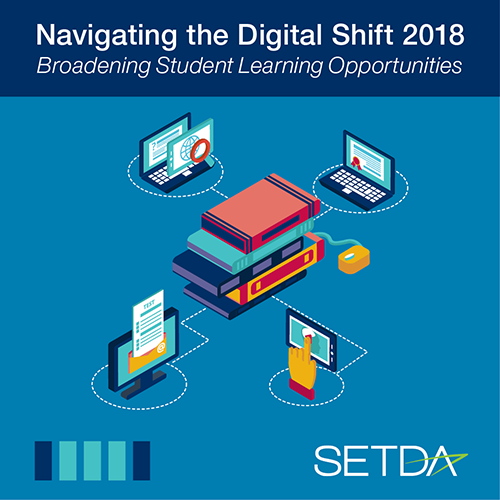
Navigating the Digital Shift 2018
With the transformation to digital learning, more and more states are enacting policies and guidelines to support the implementation and utilization of digital instructional materials, applications and resources. This publication highlights how state policies and guidance are supporting the transformation to digital learning, specifically the policies and processes around the selection, curation, procurement and funding of digital instructional materials.
-
Quality Materials
Many factors contribute to quality instructional materials. Though definitions may vary somewhat from one professional organization to the next, all agree that quality materials should be robust materials aligned to learning standards regardless of whether the materials are print or digital, full course materials or supplemental materials, open or all rights reserved copyright.
SETDA Criteria
Quality instructional materials are content-rich materials aligned to standards that are fully accessible and free from bias. They support sound pedagogy and balanced assessment to help teachers understand and interpret student performance.
Quality Instructional Materials must be:
- Aligned to state, district, and building learning standards as measured by widely-accepted evaluation tools.
- Current, relevant, and accurate content that is user friendly, fully accessible for all learners, and free from bias.
Full-course, core instructional material should:
- Emphasize the key areas of focus within each course, addressing the progression of learning skills, and vertically articulating content with other courses to ensure coherence.
- Support differentiated learning behaviors and include resources for students who struggle and opportunities for students to be challenged.
- Include a balanced assessment strategy to help teachers understand and interpret student performance.
- Incorporate technology, where appropriate, that supports quality teaching and learning.
Criteria from Others
-
Shifting to Digital
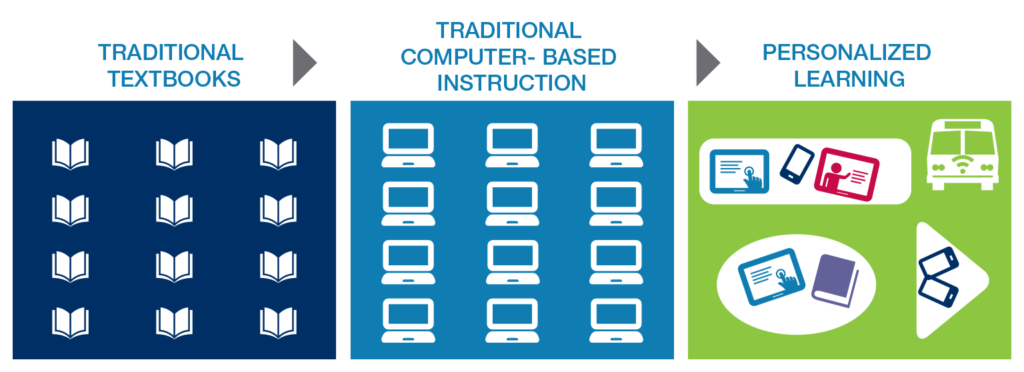
When considering digital instructional materials, in addition to the quality standards for print materials, leaders need to ensure that the materials will be easily and seamlessly accessible for all learners. In addition, the digital version of materials should leverage technology tools and resources so that it is dynamic, interactive and engaging.
Digital Considerations
Access: Both high-speed broadband and device access, in and out of school, are critical to fully implementing digital instructional materials to support college and career goals.
Interoperability Considerations: The acquisition of complementary systems that work together is a necessary condition to efficiently implement digital instructional materials and resources and maximize the benefits of those resources.
Accessibility for All Students: Providing accessibility for all students must be a consideration when acquiring, developing and implementing digital instructional materials.
Resources: SETDA Digital Content Essential Conditions and ISTE Digital Learning Essential Conditions
Key Questions
- If digital, how will you deliver the content ? Do you use a content delivery system/learning management system?
- Is the content dynamic ? Does the digital version offer more than a simple PDF of the text ? Does it leverage technology tools to provide interaction and customization?
- Is the content fully accessible ?
- Is the content interoperable across systems ?
- Does your school/district have the technology capacity to deliver content efficiently and effectively?
- Does your school/district have adequate internet access to fully utilize the instructional materials (i.e., speed, reliability)?
- Do students have ubiquitous device access in school?
- Do students and teachers have ubiquitous device access out of school?
- Is the broadband infrastructure sufficient for simultaneous access for most users?
- Is wi-fi available on campus in all learning spaces ?
- Do all students and teachers have internet access at home, and/or the community to effectively utilize the instructional material at any time?
-
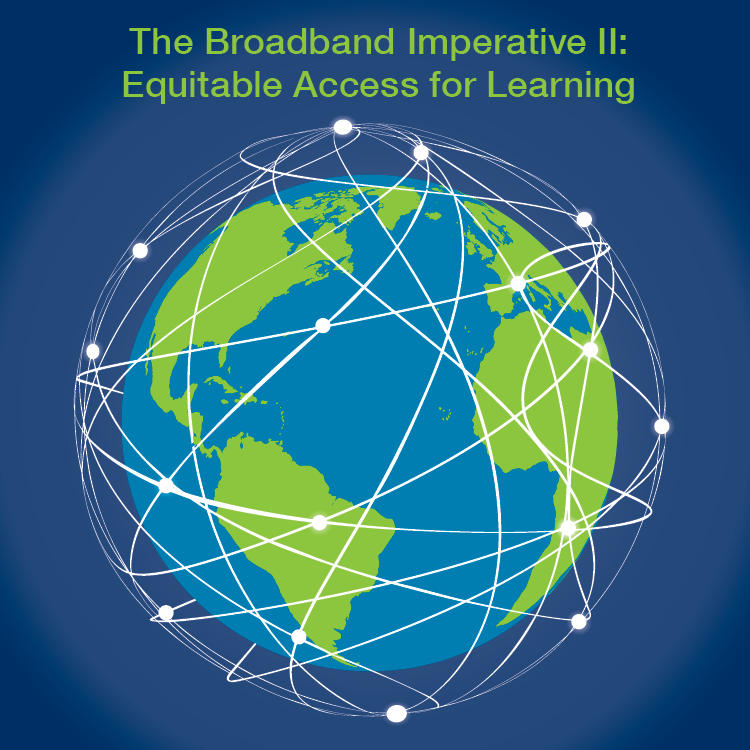
Broadband Imperative II: Equitable Access for Learning
This SETDA report advocates for increasing robust broadband access both in and out of school to best prepare all students for college and careers. Recommendations include: Increase Infrastructure to Support Student-Centered Learning, Design Infrastructure to Meet Capacity Targets, Ensure Equity of Access for All Students Outside of School, Leverage State Resources to Increase Broadband Access.
-
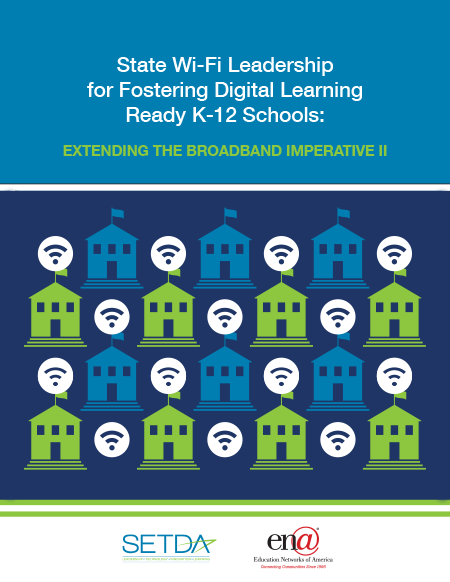
State Wi-Fi Leadership for Fostering Digital Learning Ready K12 Schools
This paper explores the steps states are taking to address the wireless equity gaps that exist among their schools. Leaders from Illinois, New Mexico, North Carolina, and Utah outline the planning, policy, funding, and management approaches their state agencies and education technology leaders are adopting regarding Wi-Fi, and they share their recommendations for promoting and/or creating equitable access opportunities to high-quality Wi-Fi connectivity.
-
Curriculum Standards
In most states academic/curriculum standards are managed in a spreadsheet, word document, pdf, or other manual tool. The lack of machine-readable standards makes it difficult for districts in those states to align digital content and assessments to state curriculum learning standards in digital learning tools. The effort and cost required to maintain alignments significantly limits the ability to effectively share digital resources aligned to standards between education entities in the state.
Additionally, the use of high quality digital content across states present significant challenges. Districts from other states cannot utilize digital content if there is not a curriculum standards crosswalk that aligns content to academic standards. Teachers from other states cannot easily use a resource as a primary instructional tool if the curriculum standards are not clearly defined in that resource.
-
Student Learning Goals
- Review and understand the target learning standards or recommended frameworks for each content area.
- Define the learning behaviors your district has defined as important and that instructional materials need to support it.
- Clarify any district instructional materials goals and priorities in the target subject area.
- Does your district focus on:
- deeper learning?
- self-directed learning?
- personalized learning?
Professional Learning Goals
- Define the teaching behaviors your district has defined as important and that instructional materials need to support.
- Are the instructional materials supporting teachers’ abilities to personalize learning?
- Assess the capacity to provide professional learning opportunities.
- Do you provide professional learning strategies for implementation of digital materials?
Key Questions
- Are you planning to select a new core curriculum for a specific content area?
- Are you considering implementing supplemental materials to support current materials?
- Are you implementing digital instructional materials?
-
- Beyond alignment to state learning standards, what other quality criteria should be considered?
- What should be avoided?
- What is the catalyst to select and adopt new instructional materials?
- Ensure that the new materials add value.
- Is your district/school using digital instructional materials?
- What is the technology capacity to deliver content.
- Internet access at school
- Wi-Fi access at school
- Student access to devices
- Student access to internet and devices outside of school
-

Learner Variability is the Rule, Not the Exception
School systems that use a one-size-fits-all model continue to under-serve nearly all of their students. These schools prepare young people for an industrial world that no longer exists.
-
Understand Where You Are
- Determine if your instructional materials for courses across the spectrum — from supplemental resources to core instructional material meet student needs.
- Determine if current core instructional materials are aligned to state learning standards by using:
- Widely recognized rubrics for the evaluation of instructional materials
- Trusted reviews from external organizations, state agencies, or school districts,
- Identify existing core curriculum strengths and challenges based on district/building data
- test scores
- classroom practice
- student work
- teacher reflection
- Identify existing supplemental materials strengths and challenges based on:
- classroom practice
- student work
- teacher reflection
- Examine current content delivery methods
- Traditional – print materials only.
- Blended – digital and print materials,
- Online – online classes
-
Assemble Review Teams
When reviewing instructional materials, it is important to include stakeholders with different expertise in the process.
- Content Expertise (teachers, curriculum directors, content coaches)
- Evaluation of alignment to learning standards, effectiveness
- Technology Expertise (educational technology directors, technology specialists, digital resource managers, librarians)
- Digital requirements, access, security and student privacy issues
- Administrative Expertise (School board members, principals, assistant superintendents, superintendents)
- Professional development capacity, accessibility, state/district policies
- Curation Expertise (teachers, librarians)
- Permitted usage, attribution, resource organization
- Community Expertise (students, parents, museums, afterschool programs)
- Ease of use, internet access, access outside of school
Key Questions
- Are there different review teams based on:
- Content area?
- Core versus supplemental materials?
- What common expertise should team members have?
- What specific skills are needed?
- Content Expertise (teachers, curriculum directors, content coaches)
-
Essential Conditions
When reviewing and selecting quality instructional materials, the following essential conditions are important components of successful adoption and implementation of instructional materials to support student learning goals. Learn more about these areas.
Budget Procurement Interoperability Student Data Privacy Professional Learning

